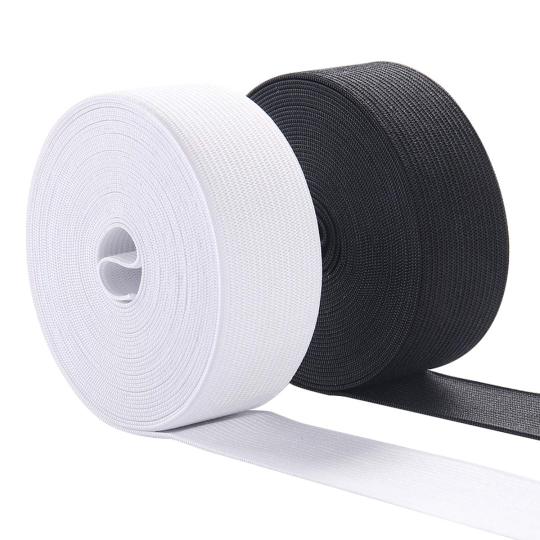#Challenges of Cloud Computing in Textile and Apparel Industry
Explore tagged Tumblr posts
Text
Elastic Market Unveiled: Beyond Stretchy Pants and into a Billion-Dollar Industry
The Elastic Extravaganza:
According to the Global Elastic Market Insights, the market was a hefty USD 1170.71 Million in 2021 and is strutting towards a projected USD 1637.67 Million by 2030, grooving at a cool 3.8% CAGR. Elastic is not just a sidekick; it’s taking center stage in various industries.

Types of Elastic: More Than Just Stretch and Shrink
This isn’t your grandma’s elastic. The report introduces us to a diverse range — strand-based for diapers, film-based for hygiene tapes, and netting-based wonders with a multilayer structure. It’s like the Avengers of the textile world, each with its unique superpowers.
Market Snapshot: The Numbers Game
Apparel steals the spotlight in the Elastic Market, boasting the largest segment with a 3.8% CAGR. North America flexes its muscles, leading the charge, while Asia Pacific and Europe are not lagging behind in this elastic race.
Segmental Shenanigans: Bras, Briefs, and Beyond
Now, let’s talk segments. The knitted segment is not just grandma’s cozy sweater; it’s a powerhouse in the elastic world, creating fabrics for everything from clothing to medical textiles. Meanwhile, the woven segment is playing a crucial role in formal clothing and outerwear. Who knew elastic had such a fashionable side?
Application Antics: Underwear Takes the Crown
Hold on to your undergarments because the underwear segment is the real MVP of the Elastic Market. Elastic materials are the unsung heroes in the world of intimate apparel, providing the perfect fit, support, and preventing any wardrobe malfunctions. The apparel segment is not far behind, vying for the top spot with its promise of flexibility and comfort.
Regional Revelry: North America and Asia Pacific Steal the Show
North America is not just the land of hamburgers and Hollywood; it’s also a key player in propelling the elastic market forward. Meanwhile, Asia Pacific is emerging as a pivotal player, embracing technology like a boss and shaping the trajectory of the Elastic Market. It’s like a tech-savvy showdown between continents.
Market Dynamics: Cloudy with a Chance of Elastic
The rising adoption of cloud-based solutions is driving the elastic market, making it the cool kid on the block. Businesses are transitioning to the cloud, and Elastic is there to provide the tools for streamlined data management and in-depth analysis. It’s like the Avengers assembling for data analysis — exciting and efficient.
Market Restraints: Privacy and Security, the Party Poopers
But wait, every superhero has its kryptonite. For Elastic, it’s the intricate landscape of data privacy and security concerns. As businesses integrate Elastic’s solutions, the challenge of safeguarding sensitive information becomes paramount. It’s like trying to keep a secret in a world full of data breaches and regulatory challenges.
Competitive Carnival: Stretchline, Taiwan Paiho, and More!
The global Elastic Market’s competitive landscape is a dynamic carnival featuring well-established brands, emerging players, and niche producers. It’s a race for innovation, and leading brands are investing in research and development to set trends in the industry. Stretchline, Taiwan Paiho, Fulflex — these names are not just catchy; they’re making waves in the elastic ocean.
Recent Developments: Stretchline’s Pandemic Pivot
In a twist of fate, Stretchline, in July 2021, used its patented innovations to tackle the impact of the Covid-19 pandemic. From anti-embolism stockings to Personal Protective Equipment (PPE), Stretchline showed that elasticity is not just about stretchy fabrics; it’s about adapting to challenges with resilience. For More Information: https://www.skyquestt.com/report/elastic-market
Key Market Trends: Cloud Computing and Elastic’s Rise
The trajectory of the elastic market is on the rise, fueled by the adoption of cloud computing and the embrace of digital transformation. As businesses move operations to the cloud, the demand for robust platforms that handle massive volumes of data intensifies. Elastic, with its suite of search and analytics tools, is riding this trend like a surfer catching the perfect wave.
Conclusion: Elasticity Beyond Waistbands
In conclusion, the Elastic Market is not just about stretchy waistbands; it’s a dynamic and evolving industry with applications ranging from intimate apparel to medical textiles. As technology advances and global trends shift, elasticity proves to be a key player in providing comfort, support, and innovation. So, next time you stretch your elastic waistband, remember, there’s a whole market stretching boundaries and making waves in the background. Stay stretchy, folks!
About Us-
SkyQuest Technology Group is a Global Market Intelligence, Innovation Management & Commercialization organization that connects innovation to new markets, networks & collaborators for achieving Sustainable Development Goals.
Contact Us-
SkyQuest Technology Consulting Pvt. Ltd.
1 Apache Way,
Westford,
Massachusetts 01886
USA (+1) 617–230–0741
Email- [email protected]
Website: https://www.skyquestt.com
0 notes
Text
Cloud Computing in Textile and Apparel Industry
Cloud Computing in Textile and Apparel Industry #cloudcomputing #cloudcomputingintextile #cloudcomputinginfashion #supplychain #fashionsupplychain #supplychainmanagement #benefitsofcloudcomputing #erpsoftware #WFXERP
Cloud Computing in Textile and Fashion Industry Shubham Anil Jain Department of Textiles (Fashion Technology) DKTE’S Textile & Engineering Institute, Ichalkaranji, India Intern at Textile Learner Email: [email protected] Introduction Cloud Computing is considered as one of the next big trend, but when it is studied from the point of different services it provides; it’s the next…

View On WordPress
#Benefits of Cloud Computing in Textile and Apparel Industry#Challenges of Cloud Computing in Textile and Apparel Industry
0 notes
Text
How screen printers need never turn down another job again.
Just in time for ISS, we spoke to David Tulipman, PMM for Direct to Garment Printers at Kornit to try to understand the challenges screen printers are facing.
David has vast experience in product marketing management for global companies in industries ranging from Semi-Conductors to 2D, 3D and Textile Printing Textile.

What are the major challenges that screen printers are facing today?
Screen printing is one of the most established printing techniques around, and screen printers have been delivering excellent results to the industry for years. Screen printing factories have been designed to print large batches and they have been able to deliver these at competitive cost and predictable, retail quality. But now, we are seeing a shift in the industry…a growing demand for shorter and medium runs.
What do you mean by small/medium runs?
500 items or more per run is considered a large run, and screen printing equipment and factory setups are ideal for such runs. Industry trends show that the total number of large printing batches in the apparel industry are decreasing.
What is the change that is emerging?
There are drivers in the apparel industry that are "squeezing" manufacturers to have to deliver much faster runs in smaller quantities. As soon as batches fall under the 500 piece mark, the whole business just becomes a lot less profitable…for a number of reasons.
What are these so-called "drivers"?
In a nutshell, our modern lives are being driven by change – the internet, cloud computing and the fact that everything is mobile is changing the way we do everything - and by that I mean FAST. And with this speed, comes the changes in fashion, influences and tastes. It's this speed, together with online shopping, that is affecting those screen printing batches we just talked about.

Fads, trends and fashions are changing faster and retailers need to adapt to this to ensure that they don't risk their inventory going bad, as the next fashion trend takes over the previous one. In addition there is a new driver on the block. Personalization is developing in many commercial areas – not only fashion. It’s a trend in itself, but it looks like it's going to stick – and its trend that screen printing just was NOT built to handle.
What are the risks to screen printing businesses?
With all the drivers we've just talked about apparel print short/medium runs are growing and are becoming a burden to screen printers. Setups costs for screen are the same whether you're setting up for 10 shirts or a 1000 and this is where the complications arise. Screen printers have variable costs that get more expensive as the run becomes shorter.

So where does this leave screen printers?
This situation puts a lot of press on screen printers, and doesn't leave them with many options, these being - to outsource, print at a loss or reject orders, the least favorable option. Inevitably printing short runs with traditional screen methods at a loss could affect customer retention and business growth.
What can the market offer to this problem?
For this particular problem manufacturers need a solution that keeps cost constant and delivers high quality screen-like printing regardless of run size. Direct-to-Garment printing (DTG) based on digital technology was introduced to the market several years ago, but it has taken time to gain confidence with this technology.
What has been holding screen printers back from adopting DTG technology?
Until a few years ago it was a less common technology, less known and less accepted for several reasons. Firstly, the print quality provided by DTG was not close enough to the quality that screen delivers, the ink price was considered a barrier to entry and there was a conception that digital was much more expensive than screen Cost Per Print regardless of the size of the run. In general, this new technology in the neighborhood had to prove itself.
How is it all evolving?
Screen printers are weighing up the pros and cons of how to handle short/medium runs and are realizing that there are numerous elements of the screen printing factory that make the entire process just too cumbersome for these runs - primarily setup and sampling costs, and lengthy supply chain timelines.
DTG has advanced significantly over the past few years and is proving itself in terms of printing results and cost effectiveness. Screen decorators are discovering and adopting DTG printing as the most practical solution for their short and medium runs.
DTG printing, such as that offered by Kornit's line of printers is able to produce remarkable results with screen-like quality, and in addition enabling photorealistic images, printing of fine details, and personalization. Kornit's latest technology release offers a breakthrough for these complex problems.
We invite you to visit us at ISS, Long Beach, next week from 19th – 21st Jan to learn more and see it first hand. Set a meeting:
http://digital1.kornit.com/ISS2018
0 notes